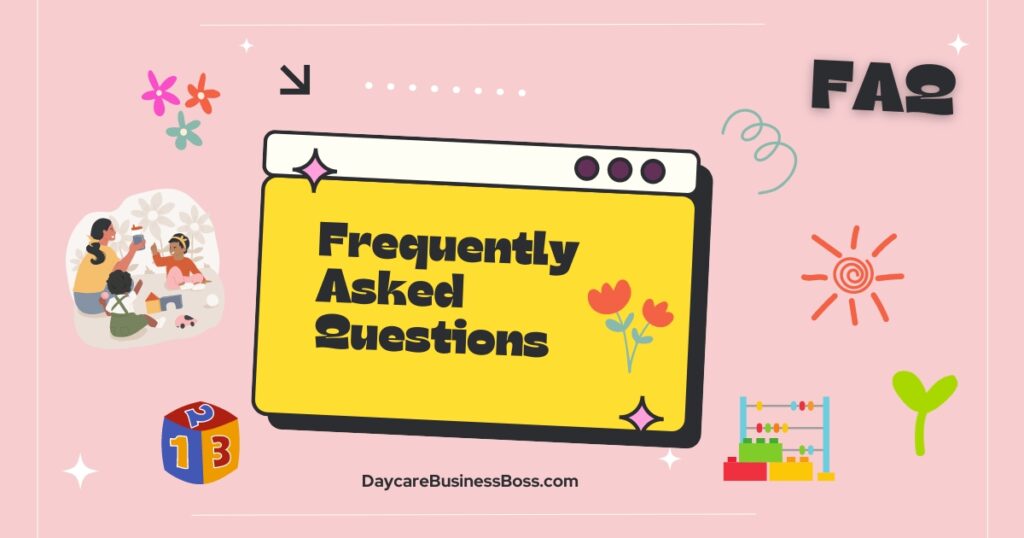Running a flourishing daycare in the ever-changing landscape of early childhood education includes more than just providing a secure and supportive environment for children. Effective marketing techniques are required to attract parents and guardians looking for the best care and educational experiences for their children. The allotment of a daycare marketing budget is a critical component of this activity. A well-defined and strategic marketing budget is essential for enhancing brand visibility, increasing enrolment, and encouraging community engagement.
The best way to determine a daycare’s marketing budget is by considering size, goals, and location. Allocate 5-10% of projected gross revenues for small businesses, adjusting based on new or established status and market conditions.
Size Matters: Understanding the Impact on Budget Allocation
A daycare’s size is a defining characteristic that has a considerable impact on the allocation of its marketing budget. Whether a daycare is large or small, its size is critical in determining the resources needed to effectively promote its services. A larger facility, with its broader scope and enhanced enrollment possibilities, sometimes necessitates a larger marketing spend to assure exposure and engagement across a broader consumer range. A smaller daycare, on the other hand, that benefits from a more close-knit and intimate community, may be able to exploit this advantage to potentially function with a reduced marketing spend.
The first strategic step in optimizing the marketing budget is to undertake a detailed assessment of the daycare’s capabilities. This includes determining how many children the daycare can comfortably accept and determining the staff-to-child ratio, which is critical in providing effective care and instruction. This assessment is critical because it serves as the foundation for calculating the proper marketing resources required to cater to the size of the institution.
For larger-capacity daycares, the increasing number of children and the resulting requirement for more staff members might result in a higher demand for marketing efforts. A larger enrollment potential means a larger target audience, demanding a more thorough marketing plan to effectively reach and engage parents and guardians. In this case, a larger amount of the marketing budget should be allocated to activities that boost exposure, such as extensive web platforms and engaging social media presence.
Consider a daycare with many classrooms and a wide range of educational programs. This larger institution would necessarily require a more extensive internet presence to adequately present its services. Investing in a user-friendly and comprehensive website that provides parents with information about the daycare’s curriculum, amenities, and testimonials becomes essential. Active participation on social media platforms not only highlights the daycare’s community involvement but also develops a sense of belonging among parents and children. As a result, spending a higher amount of the marketing budget on these sectors has become a strategic need.
Smaller daycares, on the other hand, may discover that their intimate setting allows for a more personalized marketing approach. With a smaller community to serve, these businesses can focus on developing intimate relationships through targeted outreach, word-of-mouth referrals, and community involvement. In such instances, funding distribution may be more streamlined, with an emphasis on quality encounters rather than large-scale campaigns.
Read more about: Budgeting for Bright Beginnings: Daycare Business Financial Planning
Defining Goals: Tailoring the Budget to Achieve Objectives
The search for growth in the diverse terrain of daycare administration is frequently led by a tapestry of individual aims. Each daycare, regardless of size or location, has different goals that drive its path to excellence. Whether the goal is to increase enrollment, raise brand awareness, or broaden the area of services offered, the importance of a well-structured marketing budget cannot be overstated. Aligning this budget with the daycare’s goals not only ensures a strategic and efficient approach but also serves as a compass for achievement.
Marketing budget allocation becomes a critical maneuver for daycares with the primary purpose of increasing enrollment statistics. In this case, allocating a major amount of cash to online advertising and community involvement activities is a wise decision. Investing in focused web ads enables the daycare to cast a wide net, reaching out to parents and guardians who are actively looking for childcare solutions. Community involvement activities provide a real platform for potential customers to firsthand experience the daycare’s surroundings, developing trust and familiarity. Allocating resources to activities that highlight the daycare’s facilities, curriculum, and staff competence can dramatically impact parents’ enrollment decisions.
Daycares who want to present themselves as renowned educational centers in their community, on the other hand, need to take a different approach to financing. Investing in educational tools and building ties with local schools might become key components of the marketing budget in this scenario. Allocating cash to create stimulating and thorough learning materials not only adds value to the daycare’s offerings but also indicates the organization’s commitment to providing a safe sanctuary for young minds. Collaboration with schools is consistent to build a reputation as an educational hub and attract parents who value academic achievement. Daycares show their devotion to their educational goal by allocating a portion of their budget to these activities, boosting their brand identity in the process.
Location: Tailoring the Budget to Geographic Influence

The geographic location appears as a significant variable in the intricate web of daycare marketing, casting a profound influence on budget allocation tactics. The backdrop against which daycares operate—the urban or suburban landscape—profoundly impacts their strategy as they personalize their marketing efforts to target their specific demographic. This interaction of geography, competition, and demography establishes the strategy for optimal budget distribution.
Cities and suburbs are not created equal, each with its own set of opportunities and challenges. Daycares in urban areas frequently find themselves in a bustling sea of competitors, where standing out necessitates a more active marketing approach. As a result, increasing investment in internet advertising becomes a strategic imperative. With so many options, catching the attention of parents demands a strong digital presence. Online marketing, well-optimized websites, and engaging social media campaigns are critical tools for urban daycares to cut through the clutter and reach parents actively looking for childcare solutions.
Suburban areas, on the other hand, reflect a different dynamic. A strong feeling of community exists here, and word-of-mouth marketing and local participation are extremely powerful. Personal recommendations and comments are generally prioritized by parents in suburban neighborhoods, making community involvement a vital marketing option. Suburban daycares may devote resources to organizing community events, cooperating with local companies, and building relationships with parents. Building solid ties in the local community not only fosters trust but also helps the daycare’s reputation through favorable word-of-mouth recommendations.
In this field, research is the foundation for making educated decisions. Investigating the demographics of the area, as well as the socioeconomic profile and local preferences, provide daycares with significant insights. Researching the competitive landscape—discovering what differentiates other daycares or detecting gaps in service—directs the marketing spotlight onto relevant areas.
Cultural concerns are also important. If a daycare is located in a technologically advanced town, digital marketing methods become critical. Tailoring the marketing message to the audience’s technology preferences indicates a strong awareness of their preferences.
Allocating a Percentage: The 5-10% Rule and Its Flexibility
The 5-10% rule, which is frequently cited as a key premise for small business marketing budgets, including daycares, provides a useful beginning point in the delicate dance of resource allocation. However, it is critical to view this range as a flexible foundation rather than a rigid mandate. Each daycare’s unique circumstances necessitate a careful approach that is tailored to its specific requirements and goals.
New daycares starting may find that they need to make a larger initial investment to carve out a niche in the competitive landscape. This could mean initiating a comprehensive marketing effort aimed at establishing brand recognition and resonating with potential customers. A campaign of this type could include a variety of strategic measures, such as investing in a professionally created website that highlights the daycare’s products and executing laser-focused outreach campaigns. In this case, the budget allocation could be in the 5-10% range, representing the necessary investment to establish a substantial market presence.
On the other end of the scale, established daycares with a solid reputation and a dedicated clientele frequently have the luxury of refocusing their resources. With a solid foundation already in place, many daycares may not require the entire 10% marketing budget. Instead, their focus may turn to preserving their illustrious reputation and encouraging involvement within their existing group. In this case, a smaller budget supports constant communication, community events, and strategic efforts that maintain their prestigious standing.
The impact of market conditions on daycare marketing costs cannot be overstated. As the digital landscape evolves, the online exposure of a daycare becomes increasingly important. As a result, market dynamics may influence the decision to commit a bigger portion of expenditures to digital marketing techniques. Alternatively, during economic downturns or periods of uncertainty, a sensible approach may mean interim cuts in marketing investment as the company navigates the economic tides.
Read more about: Marketing the Future: Financial Planning for Daycare Growth
Adaptability and Continuous Evaluation
The principle of adaptability is critical in the complicated dance of childcare marketing budget allocation. A flexible approach that embraces change and development helps propel childcare directors to maximize resource use and growth. This adaptability is emphasized by a commitment to regularly reviewing the effectiveness of marketing efforts and making informed adjustments as needed.
Daycare administrators who want to make the most of their marketing budget should be diligent in reviewing their efforts. The core of this approach is the regular examination of key performance indicators (KPIs). Website traffic, social media engagement data, and enrollment figures, for example, provide an empirical view of how the allotted budget is converting into real-world impact.
If particular techniques have a proven track record of growth, the prudent course of action is to capitalize on their effectiveness. In such cases, paying more funding to these high-performing channels might increase their reach and influence. If a daycare’s social media initiatives, for example, consistently increase interaction and attract new clients, allocating more resources to these campaigns can help the daycare establish an even greater online presence.
Alternatively, the adaptation concept aids administrators in dealing with tactics that may fall short of expectations. If certain techniques provide less-than-ideal results, administrators can pivot to improve these strategies or allocate resources to other promising pathways rather than remaining committed to their initial plan. This flexibility frees the budget from the constraints of unproductive techniques, allowing daycares to remain agile and sensitive to the changing needs of their target audience.
This adaptability is more than just a reactive technique; it demonstrates the daycare’s dedication to continual improvement. Daycares demonstrate a desire to develop their approach by identifying the need for changes and embracing a growth-oriented mindset that ultimately helps their clients and the organization as a whole.
Frequently Asked Questions

How should a daycare’s size affect its marketing budget allocation?
The size of the daycare has a direct impact on its marketing budget allocation. To reach a larger audience, larger daycares often demand a larger expenditure in marketing. More classrooms, activities, and services frequently necessitate a more robust web presence and larger outreach efforts. Smaller daycares may place a greater emphasis on personalized community participation. Administrators can efficiently customize their marketing budget allocation to match the facility’s size and need by examining the daycare’s capacity and staff-to-child ratio.
What factors influence the distribution of a daycare’s marketing budget?
The distribution of a daycare’s marketing budget is heavily influenced by its goals. Each daycare has its own set of goals, such as growing enrollment, raising brand awareness, or establishing itself as an educational leader. These objectives should be reflected in the budget allocation. For example, if increasing enrollment is the goal, a daycare may dedicate resources to targeted internet advertising and conducting open-house events. Daycares can efficiently accomplish intended outcomes by clearly setting goals and allocating funding to the most relevant marketing platforms.
What is the significance of geography in choosing a daycare’s marketing budget?
A daycare’s geographic location is critical in determining its marketing budget. Different places have different levels of competitiveness, demographics, and preferences. Due to increased competition, urban daycares may emphasis aggressive online advertising, whereas suburban daycares may prioritize community participation and word-of-mouth marketing. Understanding the local geography and demographics allows daycares to efficiently deploy resources, adjusting their techniques to resonate with their specific geographic target.
To learn more on how to start your own daycare checkout my startup documents here.
The information provided by DaycareBusinessBoss.com (“The Site”) is for general informational purposes only. All information on the Site is provided in good faith, however, we make no representation or warranty of any kind, express or implied, regarding the accuracy, adequacy, validity, reliability, availability or completeness of any information on the Site. Under no circumstance shall we have any liability to you for any loss or damage of any kind incurred as a result of the use of the Site or Reliance on any information provided on the Site. Your use of the Site and your reliance on any information on the Site is solely at your own risk.
This blog post is for educational purposes only and does not constitute legal advice. Please consult a legal expert to address your specific needs. Terms and Conditions. (https://daycarebusinessboss.com/terms-conditions/)

Meet Shawn Chun: Entrepreneur and Childcare Business Fan.
I’m a happy individual who happens to be an entrepreneur. I have owned several types of businesses in my life from a coffee shop to an import and export business to an online review business plus a few more and now I create online daycare business resources for those interested in starting new ventures. It’s demanding work but I love it. I do it for those passionate about their business and their goals. That’s why when I meet a childcare business owner, I see myself. I know how hard the struggle is to retain clients, find good employees and keep the business growing all while trying to stay competitive.
That’s why I created Daycare Business Boss: I want to help childcare business owners like you build a thriving business that brings you endless joy and supports your ideal lifestyle.

